The University of Twente is always looking at ways to reduce its energy usage. A selection of measures taken can be found here.
- Sustainable LED lighting in UT theaters
Due to the COVID-19 measures, many activities on Campus have been cancelled in the past period. Although this is very unfortunate, Vrijhof Techniek has put a positive spin on it by using this time to replace the old halogen lights in the theaters with LED lighting. They started in the Amphitheater with the replacement of all basic stage lighting; instead of high-power spots, where for each application a different color filter had to be placed, there are now low power red - green - blue - amber LED spots in use to put the stage in any color, without having to change the color filters each time. In addition, so-called 'moving heads' have been installed so that it is now possible to remotely turn a light to any desired position.
The old halogen lighting, however, is still ready for use in the theater's storage area. There will always be situations in which it is desirable to supplement the new LED lighting with conventional lighting in order to create special lighting effects and/or positions. An example might be that one specifically wants a green light from the left and a red one from the right, which then together create an orange spot on the floor. This can of course also be done with multi-color LED, but is then no longer available for general use during the performance; as the lamps have been assigned to that specific task.
This modernization in the UT's theater is not only more sustainable but also easier and safer to use. Another advantage is that the LED lighting is not only much more energy efficient, but also requires far fewer lights to create all the color schemes. Below you can find an overview of the old and new situation, assuming 3 clusters of red/green/blue backlighting. Because the Agora has a larger play floor, an extra cluster is needed here.
Location
Old situation - halogen
New situation - LED
Amphi backlighting
9x 500 watt
3x 150 watt
Agora backlighting
12x 1200 watt
4x 150 watt
Amphi front light
4x 1000 watt
4x 200 watt
Agora front light
6x 1000 watt
5x 200 watt
Amphi extra spotlights / moving heads
500 watt each
3x 120 watt
Agora extra spotlights / moving heads
1000 watt each
4x 120 watt
- Helophyte filter and the Cold circulation system
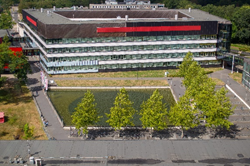 The cold circulation system is a large basin measuring 10 meters deep and 36 meters wide that holds 10 million litres of cold water, which is used during the day to cool the connected buildings and research equipment. The chillers mainly cool the water at night, because the water temperature is naturally colder then, which saves a lot of energy.
The cold circulation system is a large basin measuring 10 meters deep and 36 meters wide that holds 10 million litres of cold water, which is used during the day to cool the connected buildings and research equipment. The chillers mainly cool the water at night, because the water temperature is naturally colder then, which saves a lot of energy.On top of that, it also saves costs, because the night rate for energy is lower than the day rate. The cool nighttime climate and air-cooled chillers join forces to cool the water down to approximately 8 to 10 degrees Celsius. The cold water is heavier and is added to the bottom of the basin, whereas water that has been pumped through the buildings returns with a temperature of about 18 degrees Celsius and is added to the top of the basin. The large temperature difference creates a so-called ‘thermocline’, which means that the warm and cold layers remain separate and that the warm water insulates the cold layer of water, as it were. The cold circulation system has a cooling capacity of 11 MegaWatts, which is equivalent to more than 70,000 refrigerators. The cold circulation system also acts as a storage buffer in the event of a major fire. Currently, de Horst, Carré, the Nanolab, the Waaier, the Ravelijn, Hal B, the Zilverling, the High-pressure lab, the Seinhuis and the Teehuis are connected to the cold circulation system.
The system contains more than 10 million litres of water, which has to be treated in order to prevent corrosion and deposits on the cooling system, which we do by means of a helophyte filter. A helophyte filter uses helophytes to treat wastewater up to a point at which it is no longer harmful to the environment. Helophytes are plants that grow above water but take root in very wet soil, and they are capable of transporting oxygen to their roots themselves.
Behind the Horst, there are two fields that have been covered in gravel, sand and anti-root foil, on which we have planted reed plants. The dirty water flows onto the field on one side, before sinking through the gravel. In the soil, the waste materials are converted into nutrients for the plants in the filter. When it leaves the filter, the water is clean enough to return to the cold circulation system.
- Centrifugal chiller
The UT has several chillers to make sure that the water used to cool the buildings and research equipment is cold enough. The centrifugal chiller commissioned for this purpose in 2014 is certainly an advanced machine, with a capacity of 2.8 Megawatts. The centrifugal chiller is paired with several heat exchangers on the roof, which let it discharge the heat produced by the system. At an outside temperature of 8 degrees Celsius, the chiller works ‘for free’, because the heat exchangers (condensers) provide sufficient cooling, to the point that no mechanical cooling is required. This is also known as free-to-air cooling. On top of that, this chiller boasts an extremely good Coefficient of Performance. A machine with a COP of 3.5 requires 1kWh to produce 3.5kWh worth of cold. Our centrifugal chiller can reach a COP of anywhere between 7 and 10. Using the heat exchangers on the roof, the chiller can also discharge the heat it produces, resulting in a combined COP of 7, which is certainly above average. The older chillers are only used in extreme heat and are primarily used at night, because it costs less energy to cool the colder evening/night air than the warm daytime air.
- Heat exchangers
In the Carré, Nanolab, Zuidhorst and Meander buildings, heat exchangers extract energy from exhaust gases. A condenser installed in the outlet of the steam boiler heats the water in a large water basin, thus pre-heating cold drinking water, for instance, with heat that would otherwise have disappeared through the chimney. This approach also reduces limescale deposits and corrosion (rust), improving yield.
- Heat recovery system in the Spiegel
The air treatment unit installed in the Spiegel building features a heat recovery system. In wintertime, extracted indoor air is much warmer than outdoor air, which means that a heat exchanger can be used to transfer the heat from the extracted (indoor) air to the incoming outside air, which is colder. This prevents heat loss, and the process can simply be reversed in the summer.
- Demand-driven delivery
Setting up systems to be demand-driven ensures that no more energy is consumed than strictly necessary. Carbon sensors and heat sensors monitor quality and adjust the inflow and outflow of air accordingly. An example: One of the buildings on campus always used to be particularly warm, because 90°C water, destined for the heating system, would flow through the pipes all year long. Now several changes have been made to the system, hot water only flows through the pipes when there is a need for heat: when the heating is switched on.
- Booking system linked to climate control system
Study areas and lecture halls are only heated or cooled when they are in use, in addition to being pre-heated when necessary. To do so, the climate control system retrieves information from various booking and scheduling/timetabling systems. Now, study areas are only lit when they have been booked, and unbooked rooms are not heated.
- Covered swimming pools
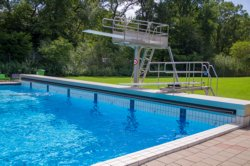 To prevent heat loss, the pools are covered when they are not in use. The pool used for swimming classes is even equipped with solar slats, which block outbound heat whilst allowing incoming heat (from the sun) to pass through.
To prevent heat loss, the pools are covered when they are not in use. The pool used for swimming classes is even equipped with solar slats, which block outbound heat whilst allowing incoming heat (from the sun) to pass through. - Solar collectors and solar water heaters
Swimming pool and shower water heated by solar collectors
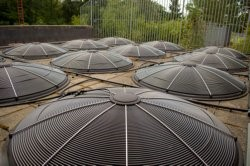
The pool and shower water is heated by 40 solar collectors. The panels are located on the roof of the changing room, the current boiler and the rooftop terrace.
Solar water heaters for Sports Centre
The Sports Centre boasts two solar water heaters with a combined output of 52 GJ per annum. Gas-fired supplementary heating - amounting to 1280 m3/year, which is comparable to the annual energy consumption of a single household - is used to meet the entire heating demand.
- LED interior lighting
When a lamp has to be replaced, it is replaced with an LED. If possible, it is also linked to a motion sensor (not in laboratories for safety reasons). AN annual budget has been reserved in the maintenance plan for this purpose.
- LED outdoor lighting
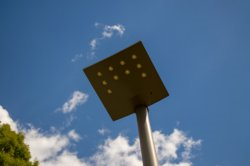 In recent years, the UT has switched to using dimmable LED outdoor lighting. Approximately 80% of all lampposts are now equipped with LEDs. Now, it is possible to configure light intensity for each road, intersection, cycling path or car park individually, and lighting systems need not always be set to 100%. Safety is paramount, of course, but adjusting lighting intensity can help us save energy and prevent unnecessary light pollution.
In recent years, the UT has switched to using dimmable LED outdoor lighting. Approximately 80% of all lampposts are now equipped with LEDs. Now, it is possible to configure light intensity for each road, intersection, cycling path or car park individually, and lighting systems need not always be set to 100%. Safety is paramount, of course, but adjusting lighting intensity can help us save energy and prevent unnecessary light pollution. - Demand-driven lighting in public areas
We have the habit to leave the light on even though it may not actually be needed. In the rooftop structure of the Carré building, which housed the technical room, the lighting used to be on 24 hours a day. This has now been changed, and the lights are switched on and off automatically. The lighting system in the stairway of Ravelijn has also been modified. It is important that the stairwell be illuminated 24/7, but switching on only one of the two fixtures is enough to comply with safety requirements and save energy at the same time. Such measures have a visible impact on energy consumption for public lighting.
- Climate Facade on Spiegel
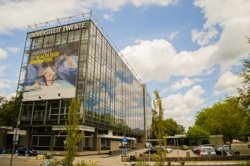 A climate facade is a glass facade placed around a building like a second shell. In 2000, such a facade was installed on Spiegel. The sun heats up the air in the space between the facade and the building, creating a heat buffer that reduces the demand for heat in wintertime and keeps the building comfortable in spring and autumn. The top of the facade is equipped with flaps, which are opened when both the outdoor and the indoor temperature at least 20°C. All ventilation is based on natural mechanisms: warm air rises and cooler air flows into the facade at the base of the building. In addition, the building is also equipped with blinds to keep as much heat out as possible on hot, sunny days.
A climate facade is a glass facade placed around a building like a second shell. In 2000, such a facade was installed on Spiegel. The sun heats up the air in the space between the facade and the building, creating a heat buffer that reduces the demand for heat in wintertime and keeps the building comfortable in spring and autumn. The top of the facade is equipped with flaps, which are opened when both the outdoor and the indoor temperature at least 20°C. All ventilation is based on natural mechanisms: warm air rises and cooler air flows into the facade at the base of the building. In addition, the building is also equipped with blinds to keep as much heat out as possible on hot, sunny days. - Reduced energy consumption thanks to carbon sensors
The air exchange system is controlled by carbon sensors. When carbon levels remain below a certain standard, e.g. when a room is not in use, less new air is supplied when not strictly needed, resulting in less unnecessary energy consumption. Carbon sensors also benefit comfort by regulating the indoor climate: although the Working Conditions Standard specifies a limit of 1200ppm, 800ppm is optimal.
- Tracking the energy consumption of user devices
Providing insight into the consumption of various devices increases awareness and changes how they are used. At the UT, a wide range of user devices are equipped with sensors.
- Internet-of-Things Pilot
The aim of this pilot was to investigate whether Internet-of-Things devices could be used in new construction and renovation projects. Belimo energy valves can control, monitor, measure and secure control valves connected to the Bacnet IP network. This pilot was successfully tested in Horst T1300.
- New energy control and optimization strategy pilot
Guaranteeing user comfort whilst minimizing energy consumption and making climate quality and energy consumption both visible and measurable where the starting points for a pilot with a new control and optimization strategy. This successful pilot is currently up-and-running in various buildings on campus, including Waaier (room 2) and Vrijhof (Audio room, Amphitheater and Agora). The new strategy has led to a noticeable improvement in comfort and draught problems have disappeared.
- Energy storage for later use
Phase Change Materials, a type of thermal battery, are used to store heat and cold, so that it can be used at a later date. PCMs behave like thermal batteries and are therefore highly suited to acting as heat/cold buffers.
In the basement of Zilverling, there is an air treatment unit that consists of a water cooling battery, a PCM cooling battery, a supply fan and an exhaust fan. Phase Change Materials are non-combustible, inorganic thermal salts whose phase change from solid to liquid and vice versa is used to store and release heat/cold. When it absorbs heat from the environment, the material melts, before solidifying again when the heat is released.
- Fume hoods
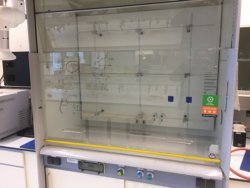 A fume hood is an extractor hood with an adjustable opening (sash), limiting the user’s exposure to harmful substances as much as possible. At its highest setting, the fume hood has an extraction rate of 650m3/hr, compared to a rate of 250m3/hr in the lowest setting. This demand-driven extraction system was implemented in Carre in 2018.
A fume hood is an extractor hood with an adjustable opening (sash), limiting the user’s exposure to harmful substances as much as possible. At its highest setting, the fume hood has an extraction rate of 650m3/hr, compared to a rate of 250m3/hr in the lowest setting. This demand-driven extraction system was implemented in Carre in 2018. - Solar panels on Technohal and Oosthorst
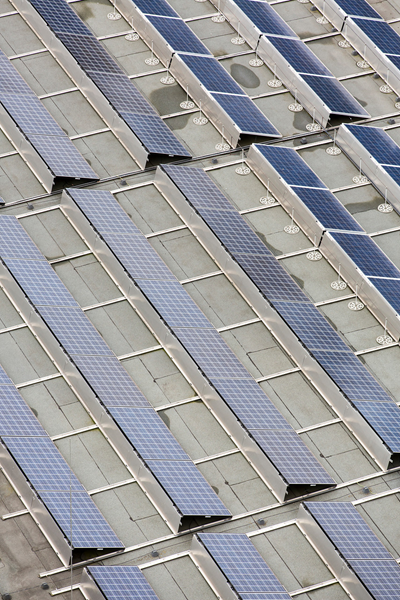 The renovated Technohal features 624 solar panels on the roofs of the side section, partly funded by an SDE subsidy.
The renovated Technohal features 624 solar panels on the roofs of the side section, partly funded by an SDE subsidy.An additional 120 solar panels are located on the roof of the Oosthorst.
- SlimPark Living Lab
The SlimPark on the UT campus consists of a solar roof that charges electric cars underneath it. It's a living laboratory as well as a demonstration site to study the optimal use of solar energy to charge electrical cars. SlimPark demonstrates the essence of a microgrid. We generate solar electricity, use this energy locally for charging and store the excess in a battery.
WHAT CAN YOU DO?
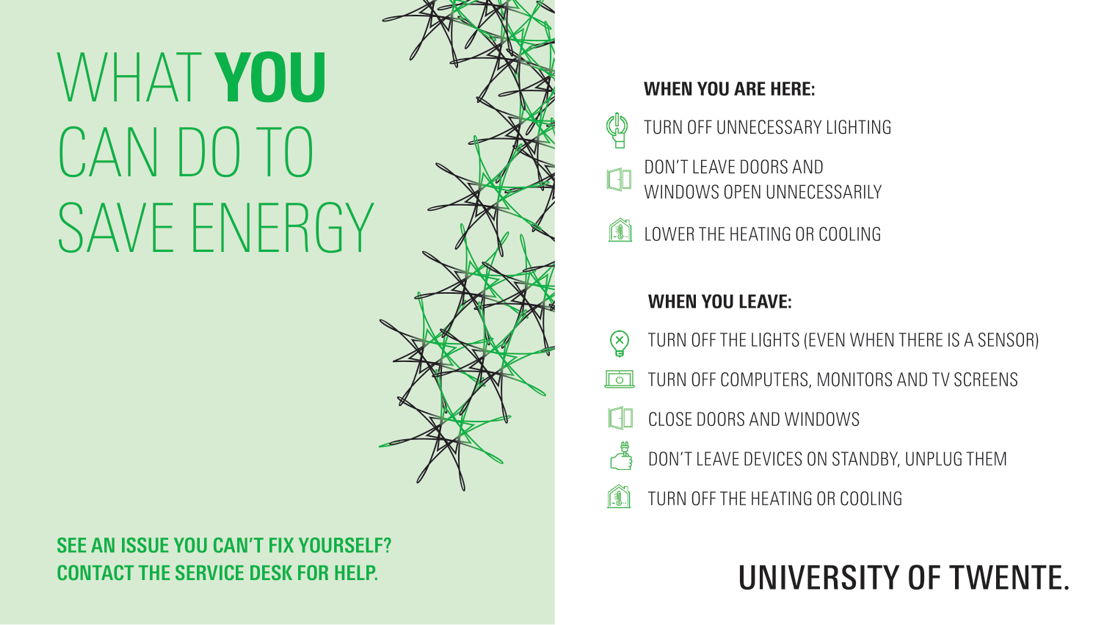
- Turn off the lights when you leave, even when a room is equipped with a sensor (they leave the lights on for up to 30 minutes after a room is empty)
- Turn off screen monitor & screen in meeting/lecture room (except in Teams-rooms)
- Turn off your laptop or PC
- Prevent standby power consumption: don’t leave appliances on standby, but turn them off and unplug them
- Unplug chargers from power sockets when they're not in use
- Close fume hoods when you’re done with your work
- Take the stairs instead of the lift when able
- Don’t leave windows open unnecessarily, especially when the heating is on
- Lower the heating by one degree and wear a sweater
- Close doors and windows when you leave a room
- Switch off or remove unnecessary equipment
- When purchasing new equipment, pay attention to energy performance.
Do you see unnecessary energy consumption that you cannot solve yourself? Then report this to your building's service desk.
